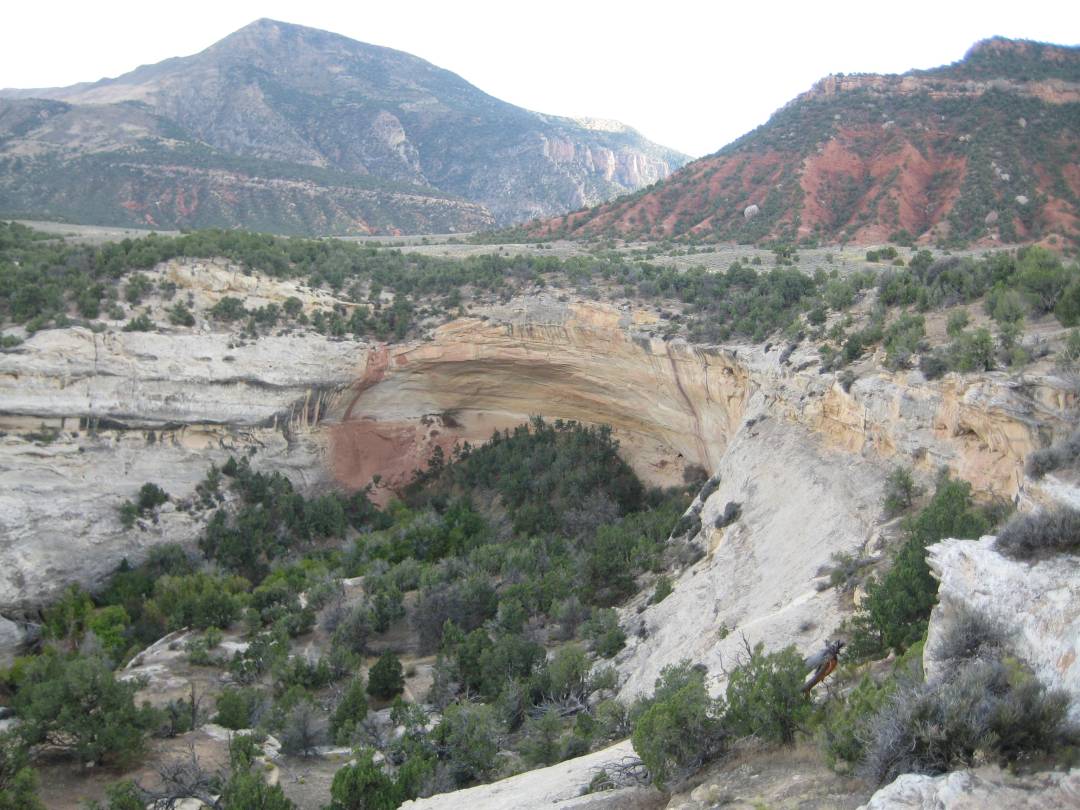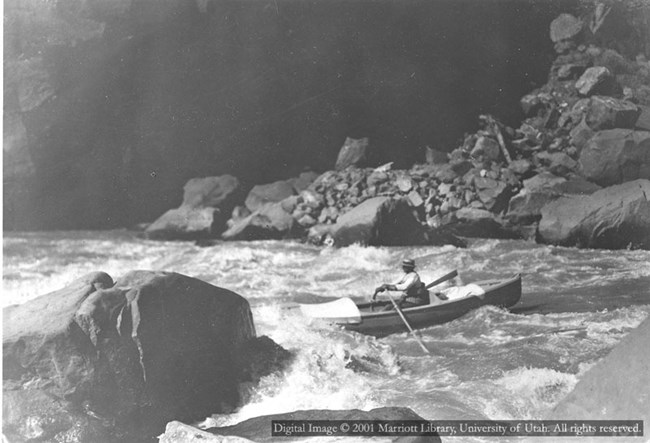
The history and geology of the Yampa River comes packed with victories of Earth’s habits, environmentalists who admired its beauty, and ancient civilizations who prospered from its wilderness.
Clouds become near neighbors to the canyon’s quiet walls, seemingly to sail by with a compliment of their black zig zags. Meanwhile yawning caves pirch above fields of tangerine blooms jittering in the desert breeze. This is a single picture from a single bend on the Yampa, a precious Colorado river that has remarkably remained in its natural cadence since its beginning.
The Yampa River flows wildly undammed throughout Dinosaur National Monument. Before its union with the Green River in Echo Park, the Yampa’s canyon ribbons through exquisite geological sights and past precious historical gems. The liberated ripples that have whittled this ancient crevice have been a source for many stories residing in its tremendous landscape.

As you explore the Yampa, you’ll soar on humongous glittering rapids made by recent debris slides and your eyes will ponder million-year-old architecture sculpted by Mother Nature’s unending finesse. Here are little pieces and explanations about the Yampa Canyon’s vast history.
Forming the Yampa

One of the awe-inducing aspects of Yampa canyon is how drastically it transitions within its steep carvings. Smooth Weber stone can metamorphose into crumbling Humbug chasms around the next corner.
The Yampa River’s origins are still widely debated, but we can share a theory from Dr. Benjamin Burger, an associate professor of Geology at Utah State University.
The Weber sandstone was deposited during the Permian period 265 million years ago. It was a time when Colorado was a peninsula off Pangea near the equator. Fast forward to 68 million years ago, North America and Europe had split, and the area was laden with huge lakes and rivers. This was the start of the Rocky Mountains’ uplift.
Jump to 30 million years ago and Colorado had fully formed the Rocky and Uinta mountain ranges. In fact, the Unitas were now quickly shrinking most likely from erosion and a weak base of rocks underneath. Meanwhile, the Green River had been flowing from a basin towards the ocean for quite some time, but then these pesky peaks got in its way.
The Green snuck through the collapsing valley, but became trapped in Lodore Canyon against dense and stubbornly ancient rock layers. Meanwhile, the Yampa had been flowing through an old drainage from the east until it also become stuck in a maze of extra-old sandstone from the Weber formation. It’s only way out was to find the Green River, which if not already apparent, came to fruition eventually in Echo Park.
The Yampa’s Canyon is mostly in the Weber formation, a layer composed of some of the oldest sandstone on Earth. But certain turns will showcase drastically different rocks like the gray and red Doughnut and Humbug formation. These sediments were deposited from the days of Colorado beaches 350 million years ago.
Tiger Wall
Tiger Wall is an adored sight on the Yampa, so much so that it is custom to give it a kiss. This affectionate tradition is for good luck getting through the upcoming class IV rapid, Warm Springs.
Canyon walls like these earn their stripes through a process called desert varnish. This is not a process of erosion. Most rock surfaces have a layer of bacterial microorganisms living on them. When rock walls become wet, soil and plant particles that were flying along on a breeze stick to the wall.
The bacteria mingles with the new particles, grubbing on their manganese and/or iron. Then those little organisms dispose of the leftover oxides in a microscopic film on the rock face. It takes thousands of years for this waste product to become visible. Once the layers of manganese/iron oxide are about as thick as a sheet of paper, the stripes will emerge like cascading watermarks.
Higher concentrations of iron will make the varnish stripes red. For Tiger Wall, the bacteria has been exposed to more manganese making them black, shiny, and smooth.
Warm Springs
The largest rapids on the Yampa will come shortly after Tiger Wall. Once you scout Warm Springs with the guides, you’ll be happy to have given some of that desert varnish a smooch for good measure.
These rapids weren’t much to talk about until June of 1965. After 11 days of nonstop rain, a stampede of loosened boulders and trees plummeted down the canyon.
The ravenous holes in Warm Springs rapids are often dodged by taking river right. But for boats filled with weight and moxie, running the middle holds an encapsulating class IV splash which billows rafters with gleaming whitewater in a drop you’ll never forget.
Landslides and rockfalls can occur without water as well. As erosion and fluctuating temperatures create shear stress, the result can be an almighty slip or fall. Warm Springs continues to change, as a rockfall from Warm Springs cliff in 2012 added to the rapid’s already technically difficult composition.
Mantles Cave

After you’ve conquered the whitewater in Warm Springs, you’ll drift towards an old homestead called Mantle’s Ranch. The Mantle’s homestead was built under a wide cave filled with treasures 400 feet above the river.
Inside this north-facing, naturally air conditioned overhang stores a lifestyle left behind in velvety apricot sand.
The archaeological site was cluttered with tools, clothing, foods, and ceremonial objects from the Fremont culture. The Fremont lived throughout the canyons in Dinosaur National Monument over 2,000 years ago. They’re traditional roles of hunting and gathering transitioned into green thumb agriculturalists.
The first excavations in Mantle’s cave began in 1933 and uncovered a wealth of ornate relics. A butterfly pendant, an orange feathered headdress, and a wrench made from the horn of a big horned sheep were among the unearthed antiques.
Today, paths and placards will guide you through the most significant Fremont archaeological site in northwestern Colorado.
Butch Cassidy: The Outlaw Trail
After Mantle’s cave, you’ll float into the confluence with the Green River. This spot crosses the Outlaw Trail made by the notorious Western hoodlums who made Hollywood fame.
Ol’ Robert Leroy Parker; the illustrious train and bank robber known as “Robin Hood of the West” made his way through this unforgiving countryside. Butch Cassidy’s first successful robbery was from a Telluride bank in 1889. With $20,750 in hand (worth more than half a million today) the Mormon-raised hellion and his accomplices dissolved into these rugged ravines.
As Butch Cassidy formed his transgressive business, his hideouts and connections along the Green and Yampa River became sociable coverups. He and his band of thieves often worked as cowhands on cattle ranch homesteads in exchange for autonomy and life-long friendships.

Their illegible trails made for easy escapes that stretched from Montana to Mexico. He and his colleagues, known as the Wild Bunch —named for their stereotypical bad-boy behavior around the bars in Vernal, Utah —were responsible for the longest string of heists in the history of the American West.
Nathaniel Galloway

Another guy raising hell in this canyon did so for a completely different reason.
Nathaniel Galloway and his 10-year-old son ran the Yampa River in spring 1909. Galloway had a stern-first boating style that startled and amazed fellow oarsmen.
With sight and navigation in his court, Galloway developed river running techniques fresh for the time and fundamental today. He had moves like the “upstream ferry” which allowed boaters to utilize the current to maneuver laterally around rocks and strainers.

Galloway’s boats were also revolutionary for rafting. The trapper/orchard-keeper designed lighter, flat bottomed wooden skiffs with noticeably easier steering. Galloway Boats are still used today to bust through rapids and glide over shallow riverbeds.
Later that summer after running the Yampa, Nathaniel ran the longest river trip just for kicks at the time. With four Galloway Boats and a group of inexperienced tagalongs, he put in at Green River, Wyoming September 12th, and arrived in Needles, California November 19th, 1909.
Dam Free
The opportunity to raft the Yampa is due to the endeavors of dedicated environmentalists and the river-loving community.
After World War II, hydropower became enormously popular. Congress began signing dam contracts one after the other and flooding enchanting gorges like Glen Canyon in 1956, making today’s Lake Powell.
A devout conservationist named David Brower took charge of the Sierra Club in 1952. He was the copywriter, photographer, filmmaker, and lobbyist of the organization who helped protect multiple national parks throughout the West. In the mid 1950s, he triumphantly fought the construction of two major dams in Dinosaur National Park.

His partner in preservation was Bus Hatch from Vernal, Utah. The Hatch family pioneered commercial rafting in the 1930s. In fact, the first paid rafting trips in the country were on the Green and Yampa rivers with the Hatches. Naturally, Bus responded to his backyard’s potential hydraulics by piling politicians in rafts from 1953 to 1954. The effort showed lawmakers exactly what they were allowing to vanish.
In 1955, the dam projects were repealed leading to one of the first environmental victories in the United States. Thanks to Brower and Hatch’s perseverance, the Rocky Mountain’s snowmelt continues on one of its last original paths.
From the very start, meanders one after the other will take you deeper into a delicately charged biome. In its protection reveals a profound dimension free from the common clutches of humankind. Prehistoric chapters reveal the conquering momentum of time along the walls, and in their presence reverberates a sense of indefinite peace. This rift brims with wanderlust, and it should be appreciated for its rare loveliness while it still has the ability to do so.
More Reading:
History and Geology of Lodore Canyon – Adventures of Rocks and Rafts









